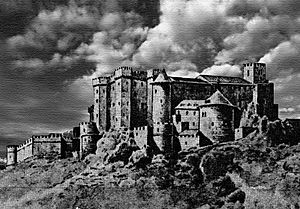Siege of Burgos (1475) facts for kids
Quick facts for kids Siege of Burgos (1475) |
|||||||
|---|---|---|---|---|---|---|---|
| Part of War of the Castilian Succession | |||||||
 Engraving of the Castle of Burgos from the work Civitates Orbis Terrarum (by Braun & Hogenberg) of 1576 |
|||||||
|
|||||||
| Belligerents | |||||||
|
|
||||||
| Commanders and leaders | |||||||
|
|||||||
The siege of Burgos was an important event during the War of the Castilian Succession. This war was fought to decide who would rule the Kingdom of Castile. The siege took place at the Castle of Burgos between 1475 and early 1476.
Contents
What Was the War of the Castilian Succession?
The War of the Castilian Succession was a fight for the throne of Castile. It happened after King Henry IV of Castile died. His half-sister, Isabella I of Castile, and his daughter, Juana, both claimed the right to be queen.
Isabella was married to Ferdinand II of Aragon, who was the king of Aragon. Juana was supported by her uncle, Afonso V of Portugal, who also wanted to become king of Castile. This made the conflict a big international struggle.
How Did the Siege of Burgos Begin?
In 1475, Queen Isabella wanted to control the city of Burgos. Burgos was a very important city in Castile. She sent her soldiers to guard the areas near Burgos.
Meanwhile, her husband, King Ferdinand, began to attack the city's strong castle. The castle had powerful cannons called Lombard guns. These cannons were used to fire at the city, even though the city itself supported Isabella.
Cutting Off Supplies
King Afonso V of Portugal was trying to help the castle's defenders. But Isabella's forces were very clever. They kept bothering the Portuguese troops. They also managed to cut off their supply lines. This meant the Portuguese could not get food or weapons.
When the Portuguese learned their path north was blocked, they had to turn back. They retreated to Toro and then to Zamora for the winter. This stopped them from helping the castle at Burgos.
Arrival of Siege Experts
By the end of November 1475, King Ferdinand's brother, Alfonso of Aragon, arrived. He brought skilled engineers who knew how to attack castles. Alfonso was famous for capturing another strong castle in Catalonia. His arrival was a big boost for Isabella's side.
The Castle's Surrender
King Ferdinand had to leave the siege of Burgos. He felt it was more important to be at the siege of Zamora. The city of Zamora had fallen quickly, but the castle there was still held by the Portuguese.
So, Queen Isabella was left in charge of accepting Burgos's surrender. The castle had been under attack for nine months. Soldiers had dug tunnels to cut off the castle's water supply. Ten days later, on December 2, 1475, the castle's defenders asked to surrender.
Terms of Surrender
Normally, there would be a two-month break before the attackers took control. However, the castle's commander, Juan de Stúñiga, surrendered early. He gave up the castle on January 19, 1476. Queen Isabella praised him for his bravery, even though he was dismissed from his post.
This act even made his father switch sides and support Isabella. Cardinal Mendoza, a close advisor to Queen Isabella, helped with the final talks. By February 2, 1476, Queen Isabella was able to visit the castle.
Why Was Burgos So Important?
The fall of Burgos was one of the first big victories for Isabella. It was a major step against Juana and her supporters. Controlling Burgos was key to controlling the entire Kingdom of Castile.
After Burgos fell, the soldiers who had been fighting there were sent to help in other battles. They joined the fight in Toro and Zamora, where the war continued.
Old and New Weapons in the Siege
The siege of Burgos was interesting because it showed a mix of old and new military technology. It was one of the last times that trebuchets were used in a major battle. Trebuchets were large machines that could throw heavy stones.
At the same time, newer weapons like cannons were becoming more common. During the siege, both trebuchets and cannons (called bombards) were used. This shows how warfare was changing during that time.
See also
 In Spanish: Asedio del Castillo de Burgos (1475) para niños
In Spanish: Asedio del Castillo de Burgos (1475) para niños
- House of Zúñiga, the family of the castle commander
- Siege of Burgos (1812)

